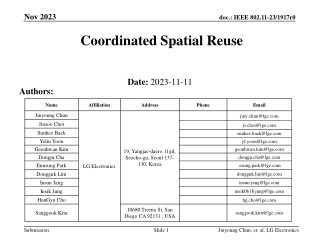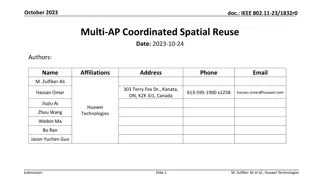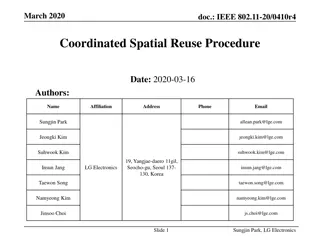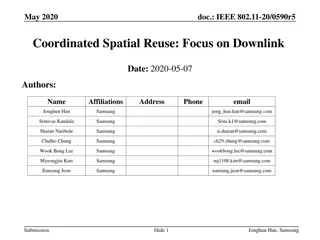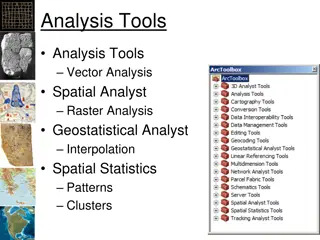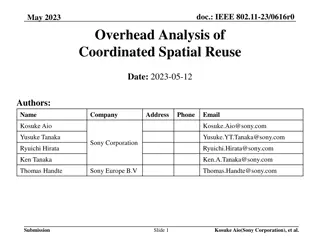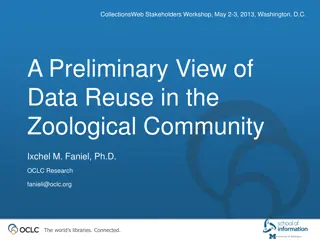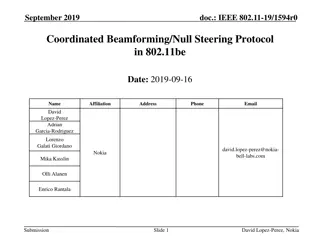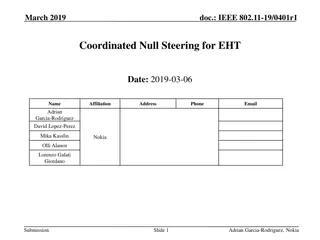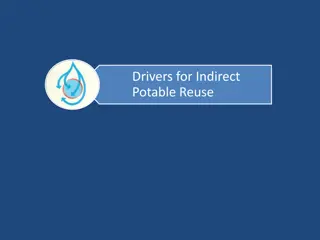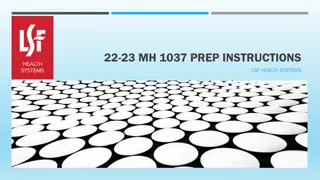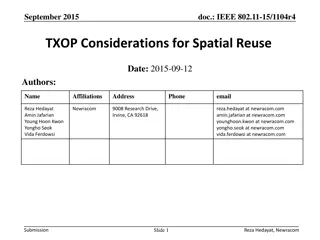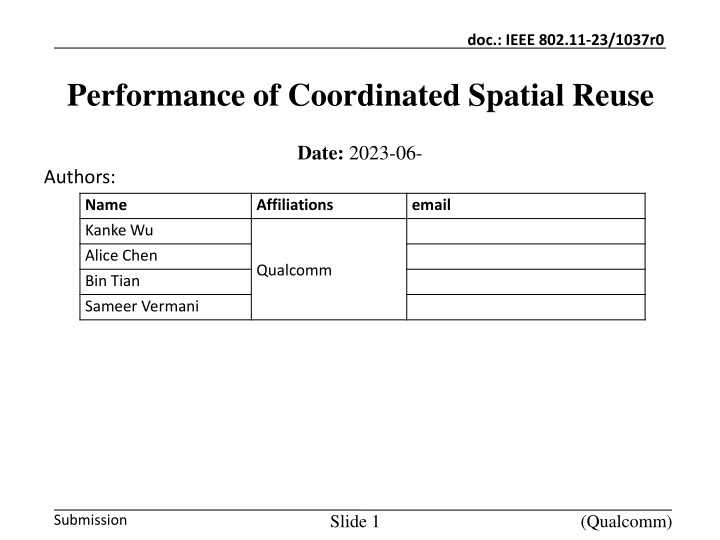
Enhancing Spatial Reuse in IEEE 802.11 Networks: Performance Evaluation
Explore the performance of Coordinated Spatial Reuse (C-SR) in IEEE 802.11 networks through PHY simulations under various assumptions. The study focuses on factors like throughput, fairness constraints, and CSI inaccuracy impact. Discover the benefits of C-SR in improving coordination among multiple APs for enhanced transmission efficiency.
Download Presentation

Please find below an Image/Link to download the presentation.
The content on the website is provided AS IS for your information and personal use only. It may not be sold, licensed, or shared on other websites without obtaining consent from the author. If you encounter any issues during the download, it is possible that the publisher has removed the file from their server.
You are allowed to download the files provided on this website for personal or commercial use, subject to the condition that they are used lawfully. All files are the property of their respective owners.
The content on the website is provided AS IS for your information and personal use only. It may not be sold, licensed, or shared on other websites without obtaining consent from the author.
E N D
Presentation Transcript
October 2022 doc.: IEEE 802.11-23/1037r0 Performance of Coordinated Spatial Reuse Date: 2023-06- Authors: Name Kanke Wu Alice Chen Bin Tian Sameer Vermani Affiliations email Qualcomm Slide 1 (Qualcomm) Submission
June 2023 doc.: IEEE 802.11-23/1037r0 Introduction Coordinated spatial reuse (C-SR) can improve upon existing spatial reuse by allowing better coordination across multiple APs through o Better selection of transmit-receive pair for the reuse transmission o More precise power control o Selective enabling/disabling of medium reuse based on coordinated measurement In this presentation we show PHY simulations of C-SR performance under different assumptions to understand the gain o Metrics considered Sum throughput Fairness constraints CSI inaccuracy impact o In the study, we consider only DL case to UL and mixed DL/UL cases conclusions can be extended Submission Slide 2 (Qualcomm)
June 2023 doc.: IEEE 802.11-23/1037r0 Four APs simulation setting Four APs are in a square setup as shown to the right where ?12= ?13= ?24= ?34= ? o The actual distance between the APs is reflected through midpoint SNR, which is the interference-free SNR at midpoint between two APs (?/2 away from AP1). o This can be to characterize the density of deployment. Two frequency reuse cases are considered: o BSS radius? = 0.75? and no overlap in BSS coverage o BSS radius ? = 0.33? One randomly dropped STA in each BSS per simulation r Pathloss model with a uniform pathloss exponent of 3.5 for all values of d>0 and NF=7 assumed o Assuming a 20MHz noise level of -94dBm PD boundary between adjacent APs is at ~22.5dB midpoint SNR ED boundary corresponds to ~42.5dB midpoint SNR o Interested in PD -- ED region d Midpoint SNR measurement Submission Slide 3 (Qualcomm)
June 2023 doc.: IEEE 802.11-23/1037r0 Sum throughput Let N be the total number of APs (in the simulation, N=4).????? is the SINR between APi and its serving station. o Calculated based on transmit powers and path loss Throughput: based on ?=? ?(?????) o f(x) is the throughput that can be obtained based on a given MCS table and SINR level o 10% PER for MCS thresholds, and a maximum MCS as MCS 13 o In our simulation, we assume both accurate and inaccurate CSI ? Submission Slide 4 (Qualcomm)
June 2023 doc.: IEEE 802.11-23/1037r0 Fairness considerations TXOP holder is randomly selected for each simulation TXOP holder is guaranteed to transmit at maximum TxPwr Transmit power of other APs o Case 1: at any power level between 0 and TxPwr to maximize sum throughput, but the combined effect of all the other APs cannot reduce throughput of TXOP holder ( CSR-?????? ) o Case 2: at max power if CCA detects signal from TXOP holder to be less than -62dBm ( CCA-ED ) Reference TDMA: randomly selected AP transmits at maximum TxPwr Submission Slide 5 (Qualcomm)
June 2023 doc.: IEEE 802.11-23/1037r0 CSI inaccuracy Inaccuracy is introduced in pathloss measurement per-link and error is accumulated in the SINR calculation o Error presented in the CSI feedback for all cases o Uniform [-3,3]dB is assumed for all cases Inaccurate SINR results in o Underestimated lower selected MCS and throughput o Overestimated higher selected MCS but failed transmission To avoid failed transmission due to overestimation, each AP performs SNR backoff to avoid packet loss in MCS selection o Backoff value optimized based on simulation Submission Slide 6 (Qualcomm)
June 2023 doc.: IEEE 802.11-23/1037r0 Sum Throughput, accurate CSI, r=0.75d In high frequency reuse environment CSR schemes with fairness constraint(CCA-ED and CSR-??????) and without fairness constraint(CSR- 4APs opt) both outperform TDMA ED PD In the region highlighted by circle, CCA-ED outperforms CSR-?????? in sum throughput, at the cost of performance degradation in sharing BSS Gain offered over TDMA (PD-ED range): o CSR-4APs opt : 87-32% o CSR-?????? 41-15% o CCA-ED : 53-2% Submission Slide 7 (Qualcomm)
June 2023 doc.: IEEE 802.11-23/1037r0 Sum Throughput, inaccurate CSI, r=0.75d With CSI inaccuracy, CSR throughput gain is reduced for both constraint case ( CSR- ?????? , and CCA-ED ) and unconstraint case ( CSR-4APs opt ) CCA-ED suffers significantly due to multiple concurrent transmissions Gain offered over TDMA (PD-ED range): o CSR-4APs opt: 58-7% o CSR-?????? 29-5% o CCA-ED: 30-(-24%) ED PD Large percentage of STAs in outage in per- STA throughput for both CSR-4APs opt and CCA-ED case for some midpoint SNR (in appendix) Submission Slide 8 (Qualcomm)
June 2023 doc.: IEEE 802.11-23/1037r0 Sum Throughput, accurate CSI, r=0.33d In low frequency reuse environment ED With r=0.33d, CCA-ED , and both CSR schemes offer significant gain compared to TDMA (PD-ED range) o CSR-4APs opt : 134-118% o CSR- ?????? 75-90% o CCA-ED : 119-51% CCA-ED now has better performance than CSR- ?????? for most of the PD-ED range o Per-STA throughput indicates CCA-ED does not result in STAs with lower throughput than that of TDMA (see appendix) PD MCS table saturation has significant impact on the performance gain Submission Slide 9 (Qualcomm)
June 2023 doc.: IEEE 802.11-23/1037r0 Sum Throughput, inaccurate CSI, r=0.33d CSI inaccuracy no longer has significant impact on CCA-ED performance o Reduced OBSS interference and increase saturation In per-STA throughput(in appendix), CCA-ED and CSR- ?????? has slightly higher outage compared to TDMA, but much better than CSR- 4APs opt PD ED Gain compared to TDMA (PD-ED range) o CSR-4APs opt: 97-70% o CSR- ?????? 57-48% o CCA-ED: 90-34% Submission Slide 10 (Qualcomm)
June 2023 doc.: IEEE 802.11-23/1037r0 Summary of results We observed that C-SR gain is highly deployment scenario dependent o More gain in scenario with low frequency reuse density due to low interference and high saturation o For deployment other than 4 APs case, we may see different gain C-SR can improve sum Tput, but fairness must be considered in design o Unconstraint CSR: Provides best sum throughput Serious fairness issues: high percentage of STAs in outage o CSR-??????: Always better sum throughput than TDMA Per-STA performance is rarely worse than TDMA (by design) o CCA-ED Sum throughput gain and per-STA performance is more scenario dependent Some STAs may suffer slightly when compared to TDMA C-SR may require accurate fast rate adaptation and interference control to realize the gain Slide 11 Submission (Qualcomm)
June 2023 doc.: IEEE 802.11-23/1037r0 Appendix Submission Slide 12 (Qualcomm)
June 2023 doc.: IEEE 802.11-23/1037r0 Sum Capacity, r=0.75d Optimal 4 APs cooperation without sharing BSS achieves the best sum capacity but scarifies fairness (unconstraint case) PD boundary ED boundary CCA-ED can achieve about half of the gain offered by unconstrainted case over TDMA o CCA-ED only guarantee sharing BSS to always transmit at peak TxPwr and does not have a fixed limit on interference from shared APs o CCS-ED performs worse than TDMA around ED region, when it enables the diagonal AP for concurrent transmission Gain offered over TDMA (PD-ED range): o Optimal 4 APs cooperation without sharing BSS: 83-21% o CSR with 3dB SINR drop limit: 55-0% o CCA-ED: 59-(-13)% Submission Slide 13 (Qualcomm)
June 2023 doc.: IEEE 802.11-23/1037r0 Per-STA throughput, accurate CSI, r=0.75d Submission Slide 14 (Qualcomm)
June 2023 doc.: IEEE 802.11-23/1037r0 Per-STA throughput, inaccurate CSI, r=0.75d Submission Slide 15 (Qualcomm)
June 2023 doc.: IEEE 802.11-23/1037r0 Per-STA throughput, accurate CSI, r=0.33d Submission Slide 16 (Qualcomm)
June 2023 doc.: IEEE 802.11-23/1037r0 Per-STA throughput, inaccurate CSI, r=0.33d Submission Slide 17 (Qualcomm)

